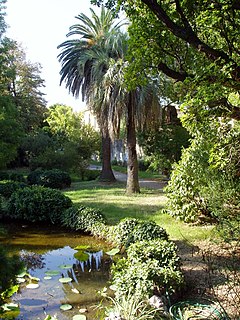
Telopea speciosissima, commonly known as the New South Wales waratah or simply waratah, is a large shrub in the plant family Proteaceae. It is endemic to New South Wales in Australia and is the floral emblem of that state. No subspecies are recognised, but the closely related Telopea aspera was only recently classified as a separate species.

Acacia cultriformis, known as the knife-leaf wattle, dogtooth wattle, half-moon wattle or golden-glow wattle, is a perennial tree or shrub of the genus Acacia native to Australia. It is widely cultivated, and has been found to have naturalised in Asia, Africa, North America, New Zealand and South America. A. cultriformis grows to a height of about 4 m (13 ft) and has triangle-shaped phyllodes. The yellow flowers appear from August to November in its natural range. Its attractive foliage and bright flowers make it a popular garden plant.

Xerochrysum bracteatum, commonly known as the golden everlasting or strawflower, is a flowering plant in the family Asteraceae native to Australia. Described by Étienne Pierre Ventenat in 1803, it was known as Helichrysum bracteatum for many years before being transferred to a new genus Xerochrysum in 1990. It grows as a woody or herbaceous perennial or annual shrub up to a metre (3 ft) tall with green or grey leafy foliage. Golden yellow or white flower heads are produced from spring to autumn; their distinctive feature is the papery bracts that resemble petals. The species is widespread, growing in a variety of habitats across the country, from rainforest margins to deserts and subalpine areas. The golden everlasting serves as food for various larvae of lepidopterans, and adult butterflies, hoverflies, native bees, small beetles, and grasshoppers visit the flower heads.

Celia Elizabeth Rosser is an Australian botanical illustrator, best known for having published The Banksias, a three-volume series of monographs containing watercolour paintings of every Banksia species.
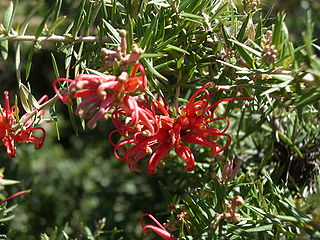
Grevillea juniperina, commonly known as juniper- or juniper-leaf grevillea or prickly spider-flower, is a plant of the family Proteaceae native to eastern New South Wales and south-eastern Queensland in Australia. Scottish botanist Robert Brown described the species in 1810, and seven subspecies are recognised. One subspecies, G. j. juniperina, is restricted to Western Sydney and environs and is threatened by loss of habitat and housing development.
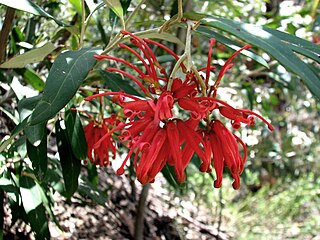
Grevillea victoriae, also known as royal grevillea or mountain grevillea, is a shrub which is endemic to south-eastern New South Wales and mountainous parts of Victoria in Australia.
Grevillea 'Fire Sprite' is a grevillea cultivar. It is a cross between G. longistyla and G. venusta. First developed in 1996, it was registered with the Australian Cultivar Registration Authority (ACRA) in 2007. It has a shrubby habit, reaching 3 m (10 ft) high and 5 m (15 ft) wide.

Kennedia nigricans is a species of flowering plant in the family Fabaceae, endemic to the south-west of Western Australia.
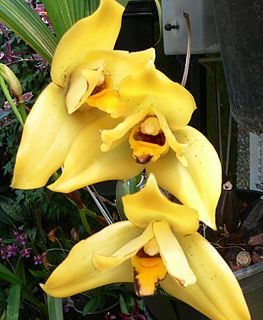
The term grex, derived from the Latin noun grex, gregis meaning 'flock', has been coined to expand botanical nomenclature to describe hybrids of orchids, based solely on their parentage. Grex names are one of the three categories of plant names governed by the International Code of Nomenclature for Cultivated Plants; within a grex the cultivar group category can be used to refer to plants by their shared characteristics, and individual orchid plants can be selected and named as cultivars.

Boronia muelleri, the forest boronia, is a flowering plant that occurs in open forest in Victoria and New South Wales in Australia. It grows to between 0.8 and 3 metres in height and has scented, pinnate leaves which have 7 and 17 leaflets, each 5 to 25 mm long and 1 to 3 mm wide. Pale pink flowers appear between October and February in the species native range. These are produced in clusters of 1 to 7 on 7 to 15 mm long pedicels.

Telopea oreades, commonly known as the Gippsland-, mountain- or Victorian waratah, is a large shrub or small tree in the family Proteaceae. Native to southeastern Australia, it is found in wet sclerophyll forest and rainforest on rich acidic soils high in organic matter. No subspecies are recognised, though a northern isolated population hybridises extensively with the Braidwood waratah (T. mongaensis). Reaching a height of up to 19 metres, T. oreades grows with a single trunk and erect habit. It has dark green leaves with prominent veins that are 11–28 centimetres (4.3–11 in) long and 1.5–6 cm (0.6–2.4 in) wide. The red flower heads, known as inflorescences, appear in late spring. Each is composed of up to 60 individual flowers.

Callistemon 'Splendens' is a commonly grown cultivar of the plant genus Callistemon. It has a compact and rounded habit and usually grows to about 2 metres high and wide, although it may grow taller. Large, well-displayed "brushes" are produced in late spring, with further flowering sometimes occurring at other times. New growth is pink-tinged and the leaves are elliptic and up to 90 mm long and 20 mm wide.

Acacia 'Scarlet Blaze' is a cultivar of Acacia leprosa originating from Victoria in Australia. It is noted for its unusual red flowers.

Kunzea 'Badja Carpet' is a cultivar of Kunzea badjaensis. It is a low-growing shrub of the Myrtaceae family found in the southeastern tablelands of New South Wales, Australia. It is similar to Kunzea capitata, but it has a lower growth form and white rather than pink flowers. Because of these differences it has been described as a distinct species. The species had previously been known as Kunzea sp. 'Wadbilliga'.
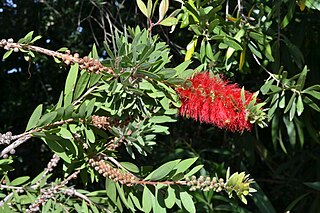
Melaleuca citrina, commonly known as common red, crimson or lemon bottlebrush, is a plant in the myrtle family, Myrtaceae and is endemic to New South Wales and Victoria in Australia. It is a hardy and adaptable species, common in its natural habitat. It is widely cultivated, not only in Australia, often as a species of Callistemon. It was one of the first Australian plants to be grown outside the country, having been taken to England in 1770 by Joseph Banks. Its showy red flower spikes, present over most of the year in an ideal situation, account for its popularity.

